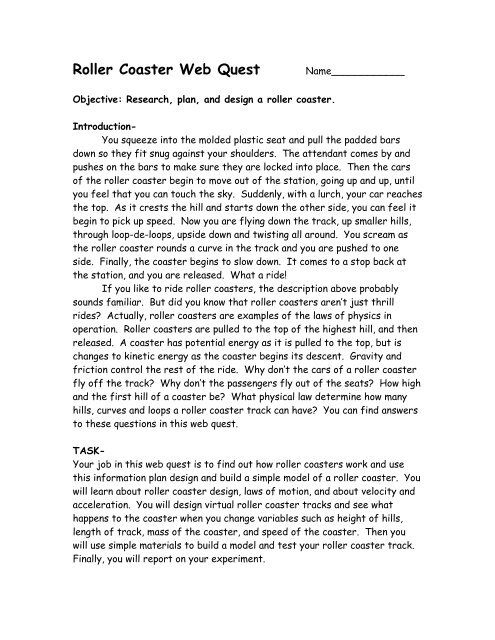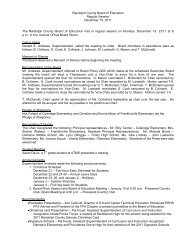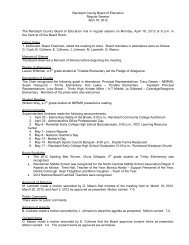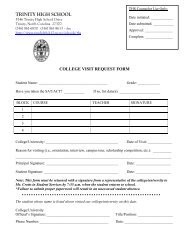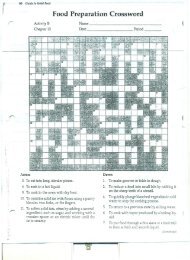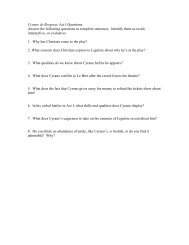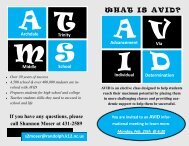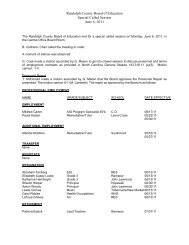You also want an ePaper? Increase the reach of your titles
YUMPU automatically turns print PDFs into web optimized ePapers that Google loves.
<strong>Roller</strong> <strong>Coaster</strong> <strong>Web</strong> <strong>Quest</strong><br />
Name____________<br />
Objective: Research, plan, and design a roller coaster.<br />
Introduction-<br />
You squeeze into the molded plastic seat and pull the padded bars<br />
down so they fit snug against your shoulders. The attendant comes by and<br />
pushes on the bars to make sure they are locked into place. Then the cars<br />
of the roller coaster begin to move out of the station, going up and up, until<br />
you feel that you can touch the sky. Suddenly, with a lurch, your car reaches<br />
the top. As it crests the hill and starts down the other side, you can feel it<br />
begin to pick up speed. Now you are flying down the track, up smaller hills,<br />
through loop-de-loops, upside down and twisting all around. You scream as<br />
the roller coaster rounds a curve in the track and you are pushed to one<br />
side. Finally, the coaster begins to slow down. It comes to a stop back at<br />
the station, and you are released. What a ride!<br />
If you like to ride roller coasters, the description above probably<br />
sounds familiar. But did you know that roller coasters aren’t just thrill<br />
rides Actually, roller coasters are examples of the laws of physics in<br />
operation. <strong>Roller</strong> coasters are pulled to the top of the highest hill, and then<br />
released. A coaster has potential energy as it is pulled to the top, but is<br />
changes to kinetic energy as the coaster begins its descent. Gravity and<br />
friction control the rest of the ride. Why don’t the cars of a roller coaster<br />
fly off the track Why don’t the passengers fly out of the seats How high<br />
and the first hill of a coaster be What physical law determine how many<br />
hills, curves and loops a roller coaster track can have You can find answers<br />
to these questions in this web quest.<br />
TASK-<br />
Your job in this web quest is to find out how roller coasters work and use<br />
this information plan design and build a simple model of a roller coaster. You<br />
will learn about roller coaster design, laws of motion, and about velocity and<br />
acceleration. You will design virtual roller coaster tracks and see what<br />
happens to the coaster when you change variables such as height of hills,<br />
length of track, mass of the coaster, and speed of the coaster. Then you<br />
will use simple materials to build a model and test your roller coaster track.<br />
Finally, you will report on your experiment.
Resources:<br />
Look at the web sites given here to research information about roller<br />
coasters. Answer the questions on separate paper.<br />
http://www.learner.org/exhibits/parkphysics/coaster.html<br />
1. What do some people call an amusement park roller coaster Why<br />
2. What gives a roller coaster its power (What makes them go)<br />
3. What “drives” the roller coaster<br />
4. What helps keep the ride smooth<br />
5. Describe the difference between a wooden and steel roller coaster.<br />
6. Click on “Design a <strong>Roller</strong> <strong>Coaster</strong>.” Follow the directions to create your<br />
own coaster. Did your design pass or fail What was your safety rating<br />
7. What did you have to do in order to make your coaster fun and safe<br />
http://search.eb.com/coasters/ride.html<br />
Go to this site for a graphic of a roller coaster with labels identifying the<br />
types of forces that affect the coaster as it follows the track. Click on the<br />
labels to learn more about that force.<br />
8. Where does potential energy happen<br />
9. Where does the rider feel like they are falling<br />
10. Describe how gravitation and centripetal acceleration make a person<br />
feel.<br />
11. Where do the riders experience acceleration<br />
12. Where do they experience centripetal force<br />
13. Describe how friction plays a necessary role in a roller coaster.
http://www.funderstanding.com/coaster<br />
MAKE SURE TO SCROLL DOWN!<br />
Visit this site to design a roller coaster by manipulating the height of the<br />
hills, sizes of the loops, speed of the coaster, and mass of the coaster on an<br />
interactive screen. This is a fun site, but it takes a while to load so be<br />
patient.<br />
14. Did your car make it all the way through without coming off the<br />
track<br />
15. What was the problem<br />
16. What did you do to make the car go all the way to the end<br />
17. What are some other fun things you did to this roller coaster<br />
http://napha.org<br />
This is the web site for the National Amusement Park Historical Association.<br />
Click on “Library” and then “Facts and Figures” to “World’s Oldest Operating<br />
Parks”.<br />
18. Where is the world’s oldest operating amusement park located<br />
19. When was it built<br />
20. Where is the oldest operating amusement park in the United States<br />
21. When was it built<br />
Go back to “Facts and Figures” and click on “Definitions”. Define the<br />
following:<br />
22. Airtime<br />
23. Hyper <strong>Coaster</strong><br />
24. Inversion<br />
25. Twister<br />
26. Inverted <strong>Coaster</strong><br />
27. Suspended <strong>Coaster</strong><br />
28. Steel <strong>Coaster</strong><br />
Click on “Great Moments”<br />
29. Describe “Pleasure Gardens” in Europe.<br />
30. When did they appear<br />
31. Where was the first vertical looping roller coaster and when was it<br />
built<br />
32. What roller coaster forever changed the face of roller coaster<br />
development and why (1959)
33. When did Walt Disney World in Florida open<br />
34. How much did it cost<br />
35. How tall and fast is the “Superman” at Six Flags in Georgia<br />
http://www.cedarpoint.com/<br />
Scroll over “Explore the Park” click on “<strong>Roller</strong> <strong>Coaster</strong>s”.<br />
36. Scroll down looking through all the coasters. What do you think is the<br />
difference between “Aggressive Thrill” and “High Thrill” ratings<br />
37. Turn the volume down on your computer. Look at each ride. Which<br />
one would you pick to ride first Why<br />
38. Click on “More Info” for your coaster. What height must riders be in<br />
feet (12 inches is 1 foot)<br />
39. What are the features of the ride Describe it.<br />
40. How fast will it go<br />
41. What is it made of (Structure)<br />
42. How far down is the vertical drop<br />
The amusement park is making a new brochure to feature a roller coaster<br />
you have designed! Write a paragraph about your roller coaster that will<br />
make people want to ride. Use lots of adjectives! Don’t forget to give it a<br />
name.


